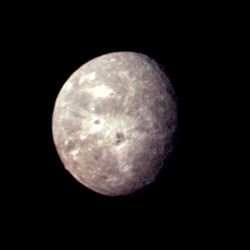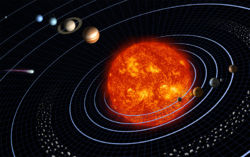Oberon
 From Conservapedia
From Conservapedia | Oberon | |
|---|---|
 Oberon, taken by Voyager 2 | |
| Date of discovery | January 11, 1787[1] |
| Name of discoverer | William Herschel[1][2] |
| Name origin | King of the fairies in the play A Midsummer Night's Dream by William Shakespeare[2][3] |
| Orbital characteristics | |
| Primary | Uranus |
| Order from primary | 18 |
| Periuranion | 583,053 km[4] |
| Apuranion | 583,987 km[4] |
| Semi-major axis | 583,520 km[5] |
| Orbital eccentricity | 0.0008[5] |
| Sidereal month | 13.463239 da[5] |
| Avg. orbital speed | 3.15 km/s[2] |
| Inclination | 0.10°[5] to Uranus's equator |
| Rotational characteristics | |
| Sidereal day | 13.463239 da[5] |
| Rotational speed | 0.00411 km/s[4] |
| Axial tilt | 0°[5] |
| Physical characteristics | |
| Mass | 3.01 * 1021 kg[5] |
| Density | 1630 kg/m³[5] |
| Mean radius | 761.4 km[5] |
| Surface gravity | 0.3469 m/s²[4] |
| Escape speed | 0.7268 km/s[4] |
| Surface area | 7,285,102 km²[4] |
| Mean temperature | 61 K |
| Composition | Water ice and rock[3] |
| Color | Light brown-gray |
| Albedo | 0.25[5] |
Contents
Discovery and naming[edit]
William Herschel discovered Oberon and its inner companion, Titania, on January 11, 1787.[1]
Sir John Herschel, his son, named the planet after the king of the fairies in William Shakespeare's comedy, A Midsummer Night's Dream.[1][7]
Orbital characteristics[edit]
Oberon is in a slightly eccentric orbit around Uranus, at an average distance of 583,520 km. Its sidereal month is about 13.46 Earth days.[5][6]
Rotational characteristics[edit]
Oberon is in tidal lock with Uranus.[5][6]
Physical characteristics[edit]
Oberon is the second largest of the moons of Uranus. It is probably composed of water ice and rock.[3][6]
Surface[edit]
The surface of Oberon has many impact craters. Many of these have bright rays that radiate from them, similar to those found on Callisto.[2][3][6]
The surface, including many of the crater floors, is partially covered with a dark material of unknown origin. Some astronomers speculate that this material is an aqueous solution that upwelled from the interior.[2][6]
Problems for uniformitarian theories posed by Oberon[edit]
Oberon poses the same problem for uniformitarian astronomy as do all the other moons of Uranus: its orbit is inclined severely to the ecliptic, though not to Uranus' own equator. How the Uranian system came to have such an inclination has never been explained.
Observation and Exploration[edit]
Oberon is visible on a dark sky through a telescope having an aperture of 30 cm or more.[3]
The only spacecraft to explore Oberon has been Voyager 2. It approached to within 470,600 km of Oberon on January 24, 1986, and took a small number of images.[8][9] No other detailed images are available.
References[edit]
- ↑ 1.0 1.1 1.2 1.3 "Gazetteer of Planetary Nomenclature: Planetary Body Names and Discoverers." US Geological Survey, Jennifer Blue, ed. March 31, 2008. Accessed April 17, 2008.
- ↑ 2.0 2.1 2.2 2.3 2.4 Hamilton, Calvin J. "Entry for Oberon." Views of the Solar System, 2001. Accessed June 16, 2008.
- ↑ 3.0 3.1 3.2 3.3 3.4 3.5 Arnett, Bill. "Entry for Oberon." The
Nine8 Planets, December 22, 2004. Accessed June 16, 2008. - ↑ 4.0 4.1 4.2 4.3 4.4 4.5 Calculated
- ↑ 5.00 5.01 5.02 5.03 5.04 5.05 5.06 5.07 5.08 5.09 5.10 5.11 Williams, David R. "Uranian Satellite Fact Sheet." National Space Science Data Center, NASA, November 23, 2007. Accessed June 16, 2008.
- ↑ 6.0 6.1 6.2 6.3 6.4 6.5 Ingersoll, Andrew P. "Oberon." Encyclopædia Britannica. 2008. Encyclopædia Britannica Online. 16 June 2008.
- ↑ Lassell, William. "Beobachtungen der Uranus-Satelliten." Astronomische Nachrichten 34:325-328, 1852. Accessed June 16, 2008.
- ↑ "Voyager Mission Description: Voyager 2 Uranus Encounter." February 19, 1997. Accessed June 13, 2008.
- ↑ Smith, B.A., Soderblom, L.A., Beebe, R., et al. "Voyager 2 in the Uranian system - Imaging science results." Science 233:43-64, July 4, 1986. Accessed June 13, 2008.
| |||||||||||||||||||||||||||||
↧ Download as ZWI file | Last modified: 02/22/2023 03:59:07 | 24 views
☰ Source: https://www.conservapedia.com/Oberon | License: CC BY-SA 3.0
 ZWI signed:
ZWI signed:
 KSF
KSF